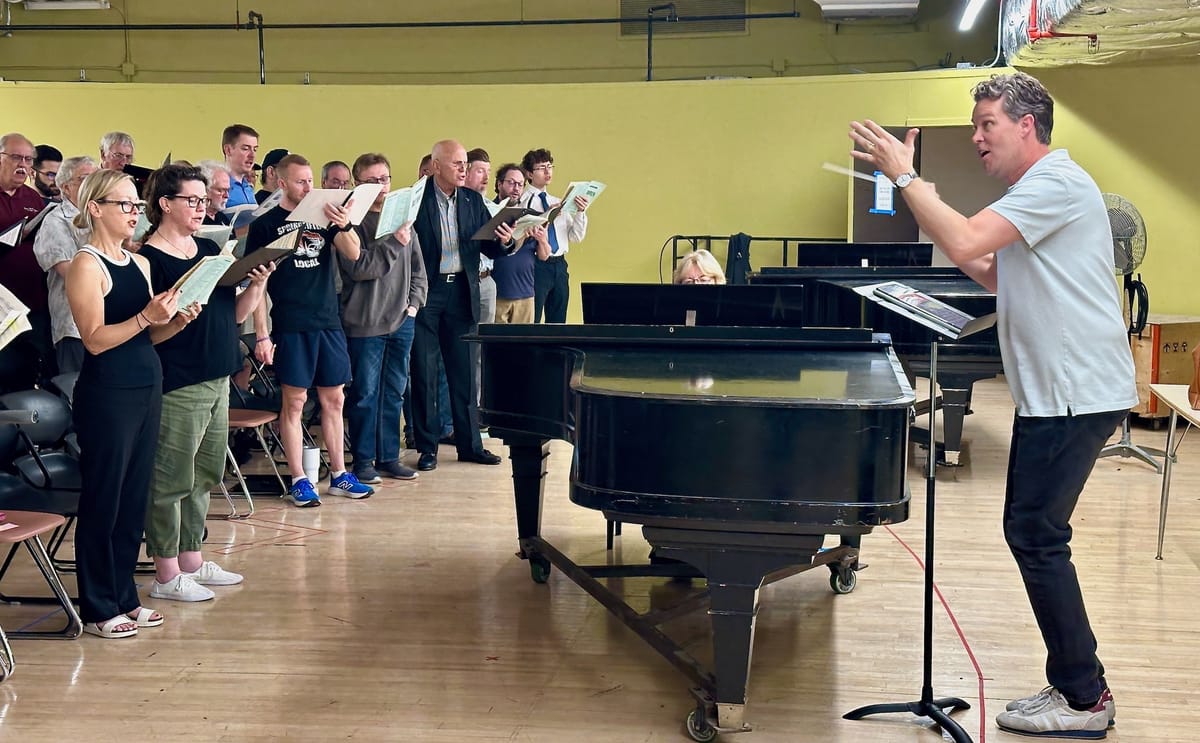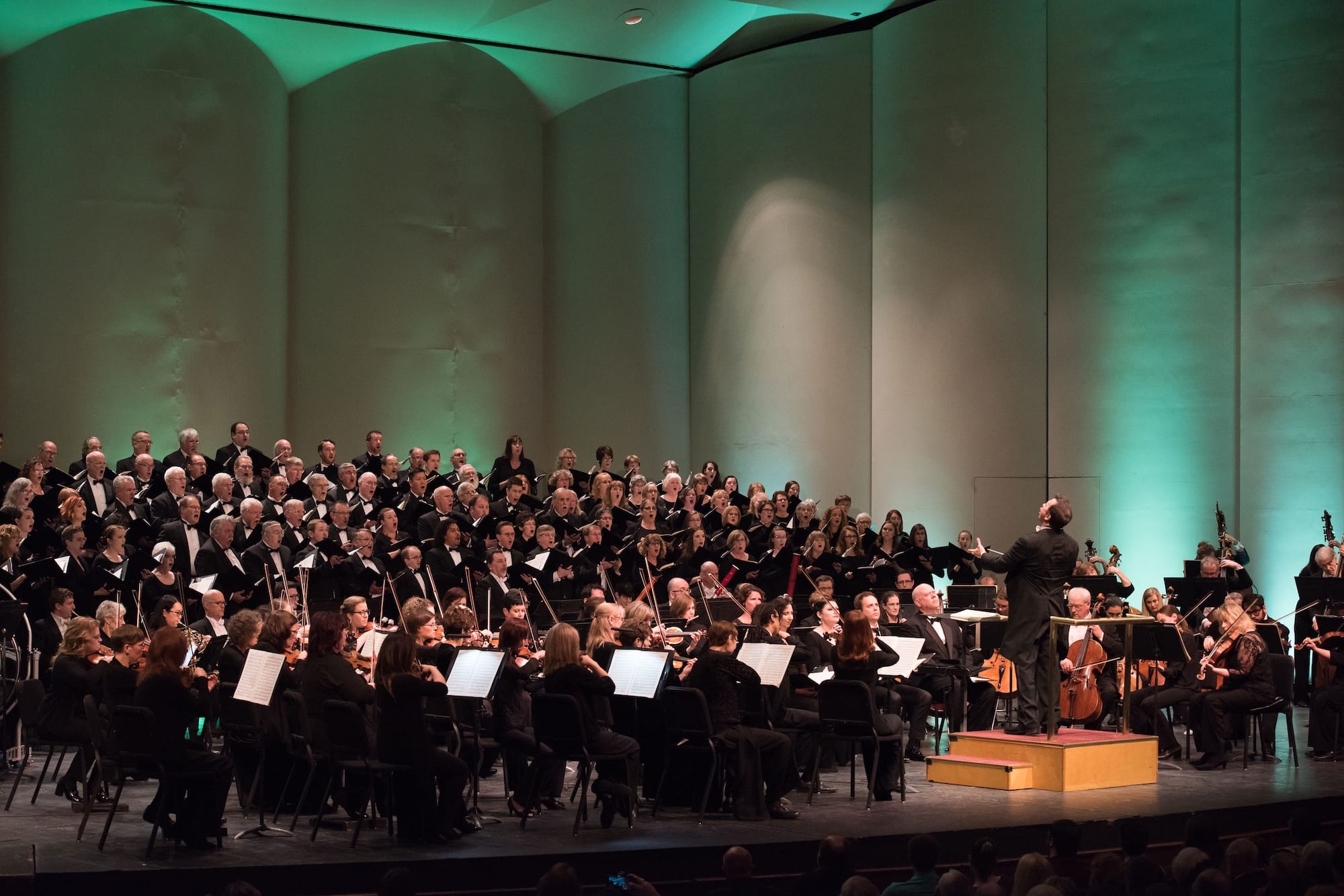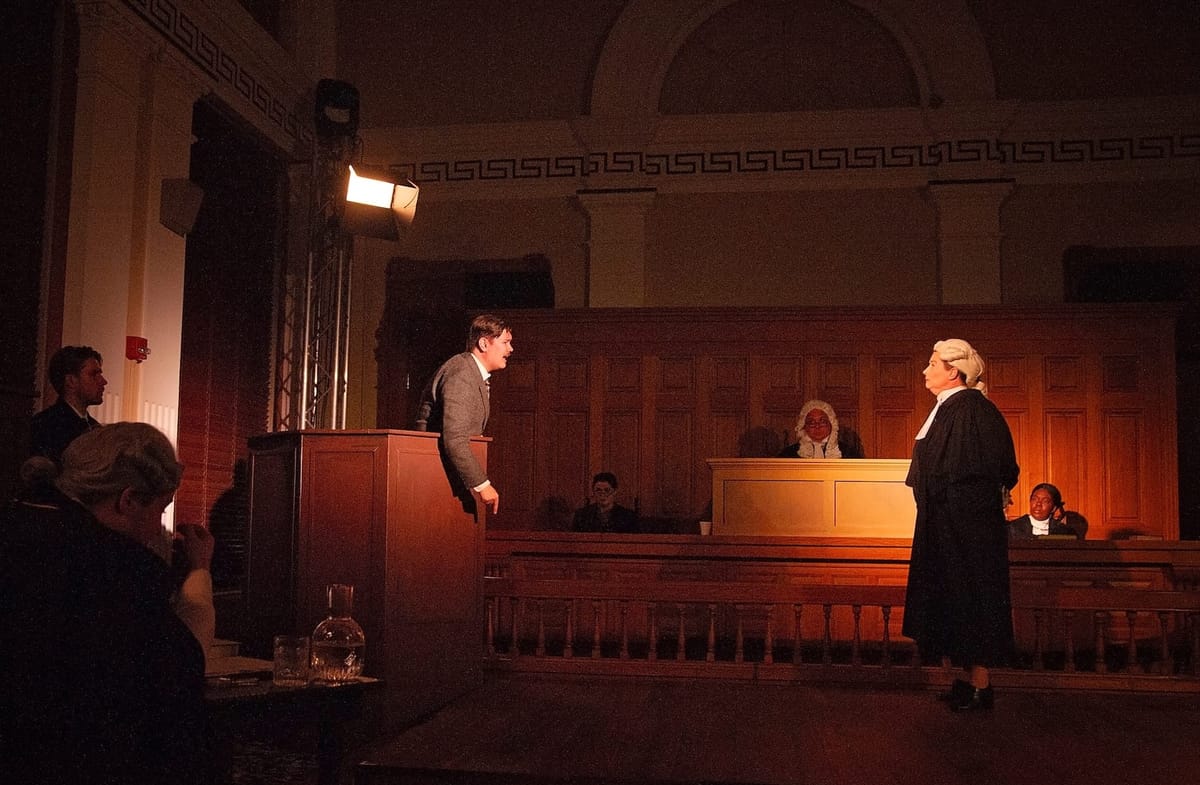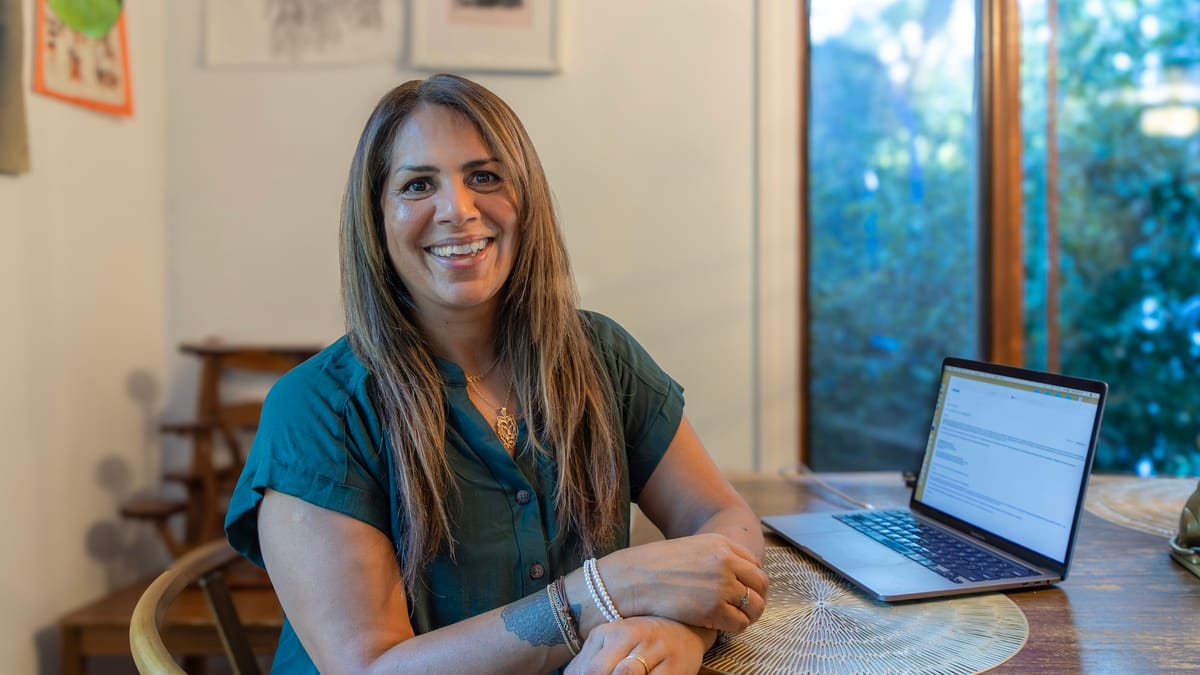Singing 'Ode to Joy' during days of disaster
The Wichita Symphony Orchestra presents Beethoven's Symphony No. 9 this Saturday with a community chorus of more than 130 singers. For one chorus member, its famous anthem is a challenge to these discordant times.

Ludwig van Beethoven is classical music’s most enduring icon. His face — and his shock of messy, greyish-black hair — is part of Western culture’s visual language, signifying the categories “composer” and “genius” even to those with no particular interest in his life or works.
The “Ode to Joy” finale of Beethoven’s Symphony No. 9 is an icon in its own right. It features one of the most famous melodies in the world, heard in countless commercials, programmed into baby toys, and adopted as the official anthem of the European Union.
So it makes sense that the Wichita Symphony Orchestra programs the Ninth about once a decade, and it makes sense that, when it appears in Wichita, it nearly always sells out. People want to be with the “Ode,” want to be part of it. It feels like a national anthem not just for the EU, but for the whole world (“der ganzen Welt,” to quote its German lyrics). People want to stand up and salute.
I don’t exempt myself from that feeling. I will be one of more than 130 Wichitans singing in the symphony chorus at Century II on Saturday evening. Yet when I learned that the Wichita Symphony would be performing the Ninth this year, I may have groaned. Not because of any disapproval of the programming choice, but because I knew that I would end up volunteering for the chorus, and, after two previous go-rounds performing the Ninth, I knew that it would be taxing to sing.
The finale, the “Ode to Joy,” which is based on a poem by Friedrich Schiller, celebrates humanity. Yet Beethoven is not overly considerate of the humans tasked with performing it. All the voice parts, but especially the sopranos and tenors, are called upon to sing forte and fortissimo over long, relentless stretches, hammering the same few high notes again and again in a way that is very tiring — especially for a chorus of amateurs. In performance, the chorus part goes on for only 16 minutes — but when rehearsals last two hours apiece, it’s very easy to over-sing and hurt yourself if you’re not careful.

It’s hard to write anything truly new about the Ninth, and my complaint about the vocal writing is certainly not an original one. “No one will ever approach the sublimity of the first movement, but it will be an easy task to write as badly for voices as in the last movement,” the opera composer Giuseppe Verdi wrote in 1878. “And supported by the authority of Beethoven, they will all shout: ‘That’s the way to do it…’”
Despite this gripe, I knew that if I didn’t sign up to sing the Ninth this spring, I’d be sitting in the audience wishing I had. So I showed up for the first rehearsal on January 23. I checked out my copy of the score, which was battered and full of pencil marks from previous singers. And then, after a few preliminaries, the symphony’s chorus master, Dr. Ryan Beeken, let us rip into the Big Tune.
“Joy, shining spark of the divine… by your magic… all men shall become brothers.”
On the day of that rehearsal, January 23, Trump ordered government facilities to stop flying pride flags. A week later, as I drove back to Wichita State for another two hours of rehearsals, the news was dominated by Trump’s “pause” on “all federal financial assistance.” A week after that, the news was of the abrupt end of USAID. And so on, up to last week’s rehearsal, held the day after Trump delivered “liberation” in the form of shockingly punitive tariffs.
The weekly rehearsals have given a strange texture to a discouraging time. “Be embraced, all you millions,” I’ve found myself bellowing, along with the rest of the chorus men. “Here’s a kiss for the whole world!” Then my mind turns to, say, Homeland Security secretary Kristi Noem’s fascistic photo op in front of a dire El Salvador prison cell crammed with half-naked deportees.
What does it mean, I ask myself, to be singing these words, this work, here, in Wichita, now?
Subscribe to our free email newsletters
Stay in the know about Wichita's arts and culture scene with our Sunday news digest and Thursday events rundown.
No spam. Unsubscribe anytime.
In the past 200 years, many people have been convinced of the Ode’s potency as a political intervention or revolutionary symbol. Whether that potency excited or worried them has varied. At the conclusion of the Ninth’s premiere in Vienna — May 7, 1824 — the ovations went on so long that a police official in attendance started to get worried. He shouted at the crowd, exhorting them to shut up and go home.
“Here,” writes Maria Popova, reflecting on the atmosphere of the premiere, “was a clarion call to humanity to discard all the false gods that had fueled a century of unremitting wars and millenia of inequality — the divisions of nation and rank, the oppressions of dogma and tradition — and band together in universal sympathy and solidarity.”
An intensely imaginative piece, the Ode invites an imaginative response from listeners. I imagine Beethoven running toward a refuge, a hope, that he calls “joy.” Sprinting, eyes fixed on it. If he feels the need to run so hard, it must be because he’s being chased. Chased by what? Despair? Perhaps by the idea that joy might not be a true refuge. Within each human heart, one may not find a font of goodwill.
This despair, this fear, does exist in the music of the finale (not just in my imagination), providing the dramatic tension that animates it. At the very first bar of the movement, Beethoven places a dissonant chord, almost a shriek, which Wagner dubbed the “terror fanfare.” Perhaps it’s the terror of human strife, the grim specter of war. Themes from the first three movements are reprised, but they don’t work; they are not an effective answer to the disturbing cry.
Then the “Joy” theme is heard and developed, but as a song without words. That’s better than what went before, but still not good enough: the terror fanfare comes back a second time. This time, the baritone soloist is roused to action, singing words that Beethoven wrote himself: “O friends, not these sounds! Let’s strike up more pleasing ones instead: Joy! Joy!”
The movement then turns to a series of episodes: dramatic variations on the “Ode to Joy” theme. The four solo singers take their turns in the spotlight, masters of ceremonies at a pep rally for the whole world.
If we could somehow convene everybody, the Ode seems to promise, we could show one another our goodwill, and a boundless spirit of cooperation would then catapult humanity to new heights. In performance, the piece serves as an emotional “proof” of this article of the humanist faith: If two or three hundred people can subsume their individual egos to create a shared peak experience, why not more? Why not all? It has to be so. It just has to be true, real, and possible, the Ode insists, with an insistence that, through half a dozen variations, keeps mounting to higher intensities.
“How am I going to wrap this up?” I imagine Beethoven asking himself, as he composes. (The same question I’m asking myself now, as I write this essay.) The finale’s form doesn’t lead to an inevitable conclusion – only to more arguments, more variations, more and bigger emotions. But that can’t go on forever. Instead, after one final choral declaration — “Joy, godly spark!” — the orchestra abruptly takes the reins, almost frantic. Bang, bang, bang, bang —

and it’s over, except for the applause.
I enjoy being part of the Ninth, shoulder to shoulder with members of my community. But I doubt that the piece has any special power to connect me with them. Their values — political, ethical, moral — remain opaque. Revealing them requires intentional conversation, not artistic communion. Unification and transformation is the subject of the Ninth, but not something the piece has the power to enact.
“Your magic reunites those whom social custom has separated,” Schiller writes. But I don’t believe in magic. Unifying change calls for slow, painstaking dialogue. If I want to “embrace the millions” on stage and in the audience — if I want to understand their values, let alone suggest that they be amended — I will have to have conversations with each of them. And they’ll have to be the kinds of frank conversations people tend to shrink from.
The Details
The Wichita Symphony Orchestra presents Beethoven 9
7:30 p.m. Saturday, April 12, at Century II Concert Hall, 250 W. Douglas Ave. in Wichita
$30-85. Student tickets are $10. Note that, as Sam states in his essay, this is a popular program, and seats are limited.
If you're never attended the symphony before, the WSO has a handy guide, down to what people wear.
Sam Jack is a poet, a classical tenor, and the adult services librarian at Newton Public Library. He performs with several local groups, including Wichita Chamber Chorale, Wichita Grand Opera, and Opera Kansas. He received a Master of Fine Arts in creative writing from the University of Montana.
⊛ Off-Broadway, a Kansas playwright meditates on the labor that defines us
⊛ Wayne Gottstine is 'back in the fight'
⊛ Star of MTW's 'Gypsy' finds purpose both on stage and from behind a pulpit
⊛ 'You don't have to give up': Clark Britton on making art into his 90s
⊛ Bygone Friends University museum housed curious collections
The latest from the SHOUT
 The SHOUTSkyler Lovelace
The SHOUTSkyler Lovelace
 The SHOUTSeth Bate
The SHOUTSeth Bate
 The SHOUTKsenya Gurshtein
The SHOUTKsenya Gurshtein
 The SHOUTTrace Salzbrenner
The SHOUTTrace Salzbrenner
